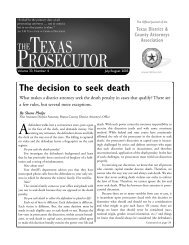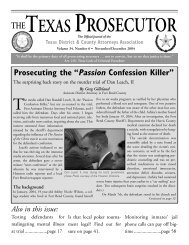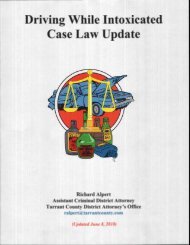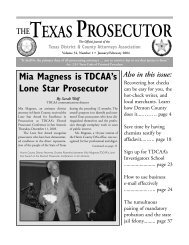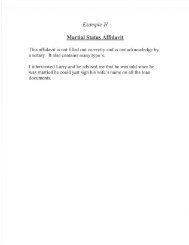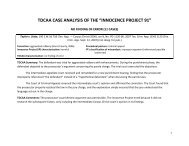Driving While Intoxicated Case Law Update - Texas District ...
Driving While Intoxicated Case Law Update - Texas District ...
Driving While Intoxicated Case Law Update - Texas District ...
Create successful ePaper yourself
Turn your PDF publications into a flip-book with our unique Google optimized e-Paper software.
equipment was obserued in the vehicle. Court found that the officer's testimony and the station<br />
house video provided sufficient corroboration of his statement he was driving.<br />
Youens v. State, 988 S.W.2d 404(Tex.App.-Houston [1't Dist.] 1999, no pet.).<br />
Where defendant was seafed in truckwith engine running, his statement atthe scene that he was<br />
driving the truck when the accident happened and further statement that 20 to 25 minutes had<br />
elapsed since the accident occurred provided sufficient basis for jury to find defendant was driving<br />
while intoxicated.<br />
Walker v. State, 701 S.W.2d 2 (Tex.App.-Corpus Christi 1985, pet. ref'd).<br />
Statement by defendant to officer at accident site that he was driver sufficient evidence to prove he<br />
was driver.<br />
Bucek v. State ,724 S.W .2d 129 (Tex.App.-Fort Worth 1987, no pet.).<br />
Defendant's sfafement that he was the driver may be sufficient when other corroborating evidence<br />
is available.<br />
Folk v. State,797 S.W.2d 141 (Tex.App.-Austin 1990, pet. ref'd).<br />
Provided there is other evidence that a "crime was committed" the identification of the defendant<br />
as the perpetrator (i.e., statement that he was drive) may rest alone upon his confession. ln any<br />
event, proof that car was registered to person defendant lived with = sufficient corroboration.<br />
B. SUFFICIENTCORROBORATIONOF'DRIVING/OPERATING''<br />
Molina v. State,2010 WL 980560 (Tex.App.-Amarillo 2010).<br />
Officerswere called outto investigate a suspiciousvehicle in a cul-de-sac and upon arrival observed<br />
defendant as/eep behind the wheel of the vehicle. The keys were in the vehicle's ignition and the<br />
car and radio were both on. Defendant was a/so in a position in the vehicle that he was able to<br />
reach the brake pedal. The police officers proceeded to wake him and, after conducting field<br />
sobriety tests, arrested him for driving while intoxicated. ln holding State had proved operating, the<br />
Court points out that any person intending to drive would first have to turn the key to start the car;<br />
the fact that the key was turned and the engine was running could be interpreted by the jury as<br />
operating the vehicle. Though no one obserued appellant start the vehicle, the fact that defendant<br />
was the only person in the vehicle, and in the driver's seat, and able to operate the brake lighfs is<br />
circumstantial evidence that the jury could have used in determining guilt.<br />
1,49



